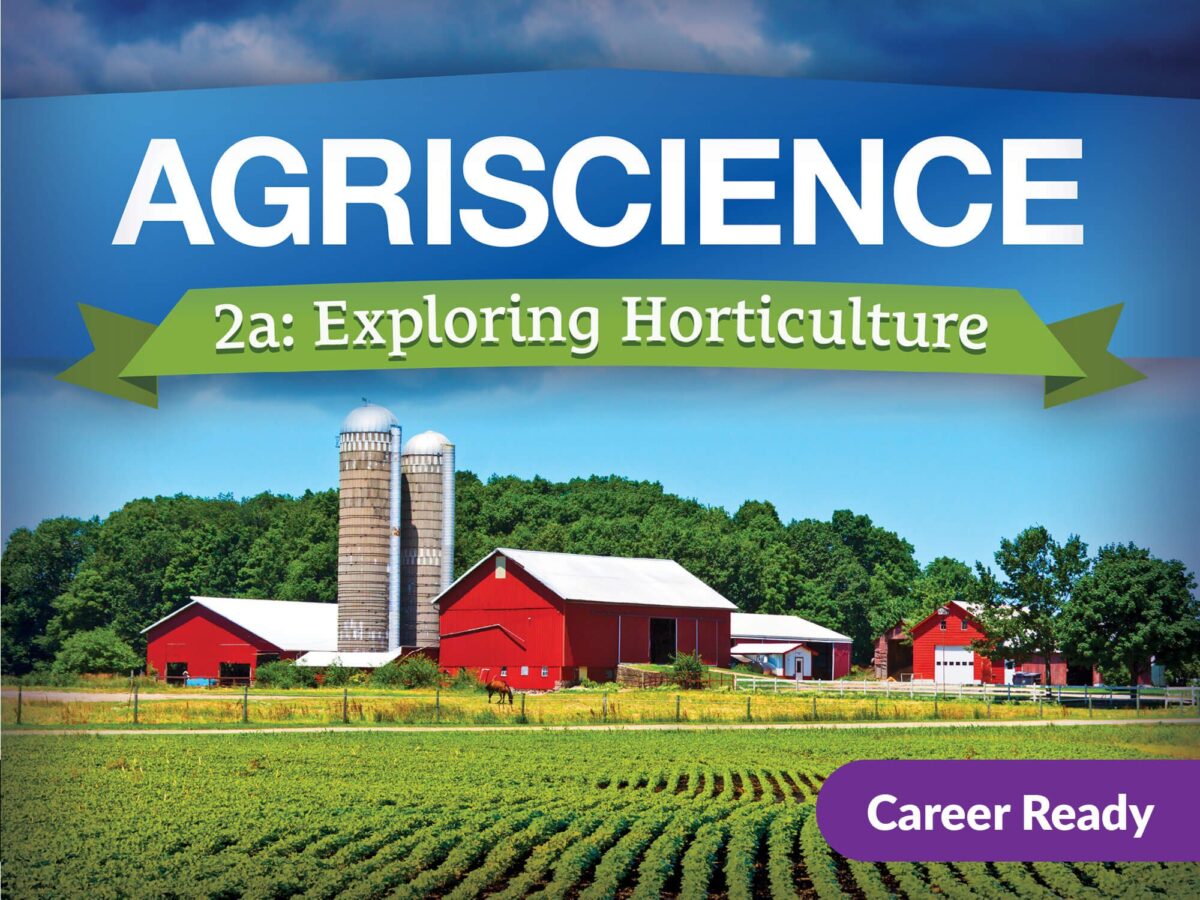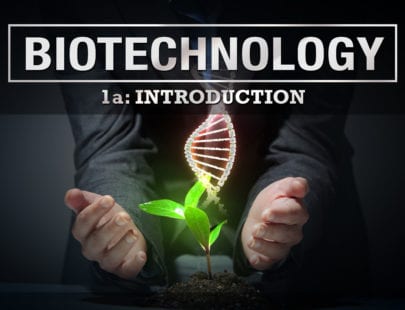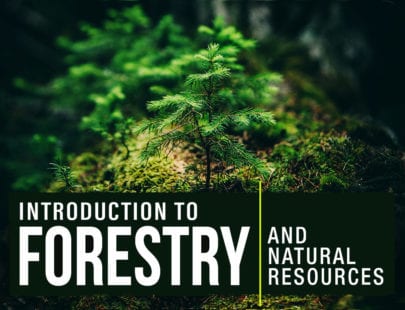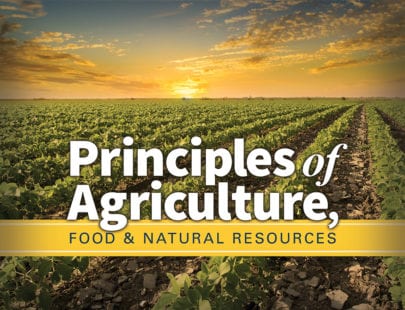
Agriscience 2a: Exploring Horticulture
Get ready to dig deep beneath the water table to examine how plants and ecosystems impact the world of agriculture science. In this course, you will explore the uses and life cycle of plants as well as plant parts, genetics, functions, and processes. You will also develop an understanding of the horticulture industry, ethical impact and trends of the trade, and career opportunities in this fruitful field. Grab your gloves and prepare to leach some agriscience knowledge.
Units at a Glance
Unit 1: Plants and Humans: A Delicate Balance
Imagine a world with no plants. What kind of foods could we consume? Even if you think, “no plants, no problem because I’m a carnivore at heart,” don’t forget that even the animals we raise for our consumption rely on plants. Relationships between plants and animals help keep balance in individual ecosystems and in the world. Plants are also the foundation of an expansive agriculture industry, with economic and health impacts that are almost immeasurable. Let’s explore this balance and the many benefits we receive from plants.
After studying this unit, you will be able to:
- Describe the major characteristics of the relationships among plants and other organisms
- Compare and contrast the domains of the horticulture industry
- Investigate the role of plants in feeding the world
- Discuss the role of plants as sources of fiber and fuel
- Differentiate between the psychological and physiological benefits of plants
Unit 2: The World of Horticulture
With an average annual salary of almost $75,000 and the ability to work nearly anywhere worldwide, the horticulture industry offers strong career prospects for almost every interest. The economics of horticulture are impactful across the United States and the globe. There are limitless possibilities to start your own business or begin a career that encompasses areas such as conservation, plant production, food science, marketing, and much more! Let’s take a look at the vast world of horticulture and opportunities to establish, grow, and thrive in a career in this industry.
After studying this unit, you will be able to:
- Describe the impacts of the horticulture industry on the United States and global economies
- Identify entrepreneurship opportunities in careers in horticulture
- Compare and contrast careers in conservation, forestry, research, and education
- Discuss the educational requirements, certifications, and opportunities for professional development in the horticulture industry
Unit 3: Plant Anatomy and Physiology
Did you know that more than 2,000 types of plants are discovered each year? Although it may seem simple to know the basics of how plants function, once you understand that there are numerous varieties of plants and a wide array of differences between them, it can begin to feel quite overwhelming! In this unit, you’ll learn the basics of plant parts and how you can tell some types of plants apart from others. From cells and leaves to flowers, plants are amazing and provide us with endless opportunities to benefit from having them in our homes, communities, and environments.
After studying this unit, you will be able to:
- Distinguish the major plant parts and their functions
- Differentiate a complete flower from an incomplete flower
- Compare and contrast monocot and dicot plants
- Examine plant cells and their major parts
Unit 4: Plant Nutrition and Processes
Have you ever felt like your diet and nutrition affected how you feel? If so, you share something in common with plants! Although it may never have occurred to you, you’ll learn in this unit that plants and people have many similarities, including the fact that they require specific nutrition to function and maintain optimum health. Without the right balance of nutrients, plants cannot complete necessary life cycles such as growth and reproduction. We will also explore how different nutrients affect plants and the major mechanisms that help plants thrive. At the end, you’ll have the opportunity to apply what you’ve learned. You might even walk away with skills that can help you keep your own houseplants healthy, happy, and thriving!
After studying this unit, you will be able to:
- Compare and contrast macronutrients and micronutrients
- Differentiate signs and symptoms of nutritional deficiencies and disorders
- Describe the process of photosynthesis
- Analyze the processes of respiration and transpiration
Unit 5: Plants and Water
The United States utilizes more than 346 billion gallons of fresh water each day, yet the amount of water that is on our planet has remained the same for two billion years. That’s hard to imagine, isn’t it? Water is essential to plant growth and life in general. In this unit, we explore the water needs of plants, water quality issues, types of irrigation, and principles that keep plants growing around our homes and communities.
After studying this unit, you will be able to:
- Evaluate the water needs of plants
- Examine water quality issues and environmental conditions that are necessary for plant and animal life
- Discuss the irrigation principles used in landscaping and nurseries
- Differentiate between the basic irrigation systems used in landscaping and nurseries
Unit 6: Plant Genetics and Genomics
Plant reproduction or propagation is the process by which the number of a species is increased. You may know that plants cross-pollinate, but did you know they can also self-pollinate? There are two types of plant propagation: sexual and asexual. Both processes are unique and have their advantages and disadvantages. The genetics of plants is amazing and constantly being studied to make crops and plants that are more productive and that have greater resilience. Let’s explore the amazing world of plant genetics!
After studying this unit, you will be able to:
- Analyze plant sexual reproduction
- Describe methods of asexual plant propagation
- Explain the process of mitosis and meiosis in plants
- Investigate the roles of DNA, heritability, and genetic applications in plant breeding
Unit 7: Plant Biotechnology
The field of biotechnology spans many areas and industries. In agriculture, the term “green biotech” refers to the agriculture industry and the work being conducted by researchers and scientists to develop crops that are more sustainable and that can be improved through the use of genetic engineering. There are many types of plant biotechnology that are being developed to helps farmers and plant producers improve the quality of their crops and plant material. The prospects for innovation and growth in the field appear limitless and are filled with exciting opportunities. However, there are challenges in this growing area of agriculture that bring about questions related to ethics and legality, as well as impacts on the economy that must be carefully considered.
After studying this unit, you will be able to:
- Explore historical achievements related to plant biotechnology and its development
- Differentiate between the different types of plant biotechnology being used in the agriculture industry
- Compare the variety of organizations that play roles in the management of plant biotechnology
- Assess some of the economic challenges and benefits related to plant biotechnology
Unit 8: Trends in Horticulture
Horticulture is an area of agriculture that many can enjoy, whether there is a large outdoor space ready for planting or just a small area on a shelf or countertop available in the home. Consumers are increasingly interested in enjoying the benefits of having fresh vegetables and herbs at their fingertips. Many people are jumping on board the growing trend of using houseplants to enhance the aesthetics of their homes. Other areas in the industry experiencing tremendous growth are precision agriculture and technology. Advances made in these arenas are helping growers and scientists find innovative ways to grow more with less space. Let’s check out some of the major trends in horticulture!
After studying this unit, you will be able to:
- Describe the benefits and challenges of growing indoor edible gardens
- Summarize current trends related to the increased demand for houseplants
- Explore the origin of precision agriculture and the ways in which it is expanding as a result of technology
- Explain some of the latest trends in precision agriculture, including artificial intelligence and unmanned aerial vehicles (UAVs)
Required Materials
Physical
- Bowl
- Clear cup (or glass, beaker)
- Container (jar, plastic pot)
- Digital camera
- Fine mesh strainer (or cheesecloth)
- Funnel
- Liquid dish soap (1 tablespoon)
- Plant (suitable to grow from a cutting)
- Pruning shears
- Resealable plastic bag
- Rubbing alcohol (70-percent alcohol)
- Salt (½ teaspoon)
- Strawberries (3 fresh)
- Tweezers
- Water
Software
- Graphic design software
- Word processing software
Optional
- Art supplies
- Audio recording device
- Flowers (two types)
- Magnifying glass
- Poster board
- Presentation software
- Rooting hormone
- Scissors (preferably with a fine tip)
- Spreadsheet software
- Video recording device



